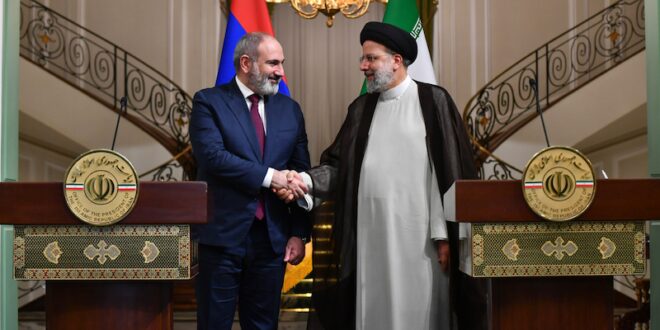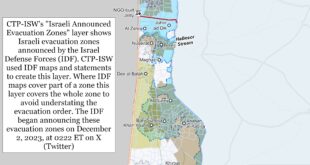Armenia, Georgia, Kazakhstan, and Kyrgyzstan are leading conduits for the evading of Western sanctions against Russia. Armenia’s current assistance to Russia builds on its three-decade experience in being an intermediary assisting Iran to evade Western sanctions. Armenia’s military, political and trade relationship with Iran has existed since the early 1990s when it defeated Azerbaijan in the First Karabakh War. Armenia’s good relations with Iran were the opposite to Azerbaijan’s very poor relations with the Iranian theocratic regime.
Armenia is one of the few democracies in Eurasia; nevertheless, it is a member of Russian-led CSTO (Collective Security Treaty Organization) and EEU (Eurasian Economic Union) that bring together authoritarian regimes. Armenia also has Russian military bases on its territory, the FSB assist in the protection of its borders, and Armenia’s military is trained by Russia and uses mainly Russian military equipment.
Armenia’s assistance to Iran in evading sanctions gave it the means to build up its domestic military industrial facilities using smuggled and stolen components from the West. Iranian Shaheed drones used by Russia to attack civilian targets in Ukraine use Western components that have been smuggled or stolen from the West through sanctions busters like Armenia, Georgia, and other countries.
In the Service of Russia
Decades of Armenian experience in assisting Iran in the evasion of Western sanctions are now being used for the benefit of Russia against which stringent sanctions were applied after it invaded Ukraine on 24 February 2022. In March 2023, the US listed Armenia as a country involved in smuggling to Russia. A recent EU sanctions package ‘focused on preventing third-country circumvention also lists entities in Armenia among the culprits.’ Cars arrived in the Georgian port of Poti, are brought to Armenia for duty free customs clearance through the EEU’s free trade agreement with Russia. They are then taken via Georgia to Russia.
In 2022, the first year of the invasion, EU exports to Russia declined by nearly half (47%). In the same year, imports from the EU to five sanction breaking Eurasian countries (Armenia Georgia, Belarus, Kazakhstan, Kyrgyzstan) grew by 48%. These five countries do not have the populations and purchasing power to consume all these products and therefore they a large proportion of these imports had been re-exported them to Russia.
Armenia’s exports to Russia almost tripled in 2022, growing by 187% over 2021. At least half of this trade was reexports of Western goods with the remainder Armenian products. Some of these were dual use goods, such as washing machines, for the consumer market and military. In 2022, Armenia imported more washing machines than all the member states of the EU!
The US Treasury Department’s Office of Foreign Assets Control (OFAC) has been relatively slow to act against Armenia and other Eurasian sanctions busters. Two Armenian registered companies with Russian owners, TAKO LLC (registered in Yerevan in May 2022) and AO PKK Milandr have been sanctioned.
The US Treasury Department’s OFAC ruled that TAKO, ‘materially assisted, sponsored, or provided financial, material, or technical support for, or goods and services to or in support of Radioavtomatika.’AO PKK Milandr is a Russian microelectronics company that is part of the Russian military research and development defence technology firm Radioavtomatika that supplies electronic goods to the Russian military.
Armenian banks (e.g., AreximBank, GazpromBank Group, VTB Bank, Bank Mellat) are handsomely profiting from the war in Ukraine. Armenia and Georgia have experienced a huge influx of refugees from Russia, many of whom have brought capital and launched new business ventures. Financial transfers from Russia to Armenia reached 3.5 billion US dollars in 2022, a massive increase from 865$ million US dollars in 2021.
Armenia’s economy boomed in 2022, growing by a record 14.2%. Under the impact of Russia’s invasion, Ukraine’s economy declined by a third. Armenia’s economy had been expected to decline due to its heavy reliance on Russia and yet grew by a record figure.
Imports into and exports from Armenia grew by record figures in 2022. Armenia’s trade turnover increased by 68.8% in 2022 over the previous year while imports grew by 63.5% over 2021. This included a two-fold increase of goods imported from the EU. Armenian exports to Russia grew three-fold in 2022, at least half of which were reexports.
Of the Eurasian sanctions’ busters, Armenia has become the main hub for Western goods reaching Russia. In addition to dual use consumer goods, these include microchips, transportation equipment, technical components, old and new cars, smartphones, and computers. Thousands of cars in Armenia and Georgia are destined for Russia where Western showrooms for cars closed following the invasion. Armenia does not produce cars but exports of cars to Russia increased from $800,000 in 2022 to $180 million a year later.
Armenia increased its import of precious metals and stones by a whopping 200%, new vehicles by 170%, electronics by 100%, iron and steel by 76%, machinery and mechanical devices by 52% and technical and medical equipment by 42%. In the same year, Armenia increased the export of precious metals and stones by a suspiciously high 200% and technical and medical equipment by 400%. Armenia does not have the capacity to use such large quantities of these commodities. In addition, these commodities were not traditionally found in Armenian exports to Russia. The scale of the growth of Armenia’s imports in 2022 make it impossible for the country’s small population of 2.8 million to consume.
Re-exports to Russia are the only answer explaining Armenia’s massive growth in trade. For example, Armenia increased its imports of microchips from the US by 515% and from the EU by 212% in 2022. Nearly all of these (97%) were reexported to Russia where they are used by Russia’s military industrial complex.
Iranian Experience Rechanneled to Russia
With a large and active diaspora in the US, Armenia ignored Washington’s warnings to ‘halt connections with Iran.’ A 2019 communique from the US Embassy in Yerevan stated, ‘We have made it clear to the Armenian government and the private sector that we expect Armenia to live up to its responsibilities as a member of the international community.’ Iran shares a 44 km border with Armenia and trade has grown to record high levels. The Iranian border is Armenia’s ‘only reliable connection to the outside world.’
Armenia and Iran discussed re-exporting Iranian gas from Armenia, a step a US diplomatic cable warned would be ‘a vastly different thing, and a huge problem for us.’ Armenia receives gas from an Iranian pipeline, which is exempt from US sanctions against Iran, and exports electricity to Iran.
The biggest scandal in US-Armenian relations took place in 2007-2008 when two US laws were broken, and Washington threatened the triggering of sanctions against Armenia. This was ‘part of a wider U.S. effort to block Iran’s access to the global arms and weapons, and technology market.’ US National security adviser John Bolton continued to raise the importance of pressuring Iran during his 2018 visit to Armenia.
The Armenian Ministry of Defence purchased from the Bulgarian company Metalica a total of 1,000 RPG-22s produced by the Bulgarian Vazovski Mashinostroitelni Zavodi (VMZ), and 260 PKM machine guns produced by the Bulgarian Arsenal company. ZAO Veber acted as an intermediary. The end user certificate was signed by then Armenian Defence Minister Serzh Sargsyan who promised they were for Armenia’s use (Bulgaria was unaware of the Iranian destination).
Armenian Defence Minister and from 2008 President Serzh Sargsyan denied the transfer had taken place saying, ‘it did not happen and could not have happened.’ A US diplomatic cable explained ‘The direct role of high-level Armenian officials and the link of the weapons to an attack on U.S. forces make this case unique and highly troubling.’
In the late 1990s, Iran increasingly sought to procure technology and expertise from former Soviet military factories and research institutes which had been devoted to military production. Armenian engineers and scientists assisted Iran in building new facilities. Armenian oligarch and President Armen Sarkisian’s Lizin biochemical company supplied biochemical equipment to the Iranian front company Al-Ahd Sadeq Trading company in the UAE.
The US State Department blacklisted Armen Sarkisian and Lizin. The biochemicals were dismantled from a Soviet factory in Armenia which had been used to grow special bacteria to produce lysine. The US government feared Iran could use the substance for its chemical warfare programme. US sanctions accused Sarkisian of involvement in ‘the proliferation of weapons of mass destruction and missiles’ to Iran.
Armenia has been criticized by the US for providing banking services to the Iranian government to evade international sanctions, skills that are now being use on behalf of assisting Russia in evading Western sanctions. A report by a U.N. panel of experts monitoring compliance with the sanctions ‘concluded Iran was constantly searching for ways to skirt restrictions on its banking sector. One state bordering Iran informed the Panel of requests from Iran to open new financial institutions.’ U.N. diplomats confirmed the unnamed state was Armenia.
The US believed, former Congressman Dan Barton said, ‘Armenia has assured the West that its banking sector is under increased control and Iran will not be able to launder money through Armenian banks. However, according to American officials, Iran has free access to Armenian banks operating in Nagorno-Karabakh. Iran can use these banks to finance its nuclear and missile programs and even finance terrorist groups in the Middle East.’
An investigation by Reuters found that Iran looked to Armenia as a means to evade sanctions against Iranian banks. Armenia was attractive not only because it is a regional ally but also because its ties to the European Union ‘could make it easier for Tehran to obfuscate payments to and from foreign clients and deceive Western intelligence agencies trying to prevent it from expanding its nuclear and missile programs.’
Bank Mellat has been under UN sanctions since 2007 accused of facilitating ‘hundreds of millions of dollars of transactions of Iranian nuclear, missile and defence entities.’ The Armenian branch of the Iranian Bank Mellat ‘is active in Armenia, providing trade and commerce-related services primarily to Iranian customers.’ Bank Sepah and ACBA Credit Agricole Bank, also with branches in Armenia, were additionally sanctioned by the UN in 2007.
Conclusions
At least five Eurasian countries – Armenia, Belarus, Kazakhstan, Kyrgyzstan, and Georgia – are assisting Russia in the evasion of Western sanctions imposed after the invasion of Ukraine and of these Armenia is the most important hub. While the first four countries are members of the Russian-led CSTO and EEU the surprise is Georgia which has become more pro-Russia under Ivanishvili’s de facto state capture.
Armenia’s three-decade old experience assisting Iran to evade Western sanctions is now being used to assist Russia to evade sanctions which are just as severe against Moscow. Iran, Russia, and China have formed an anti-Western alliance with the goal of replacing what they describe as the US-led unipolar with a multipolar world. Although Armenia is not formally part of this anti-Western axis, it is nevertheless indirectly involved through its assistance in the evasion of Western sanctions against Iran and Russia and as an intermediary in the supply of Iranian drones to Russia.
 Eurasia Press & News
Eurasia Press & News




